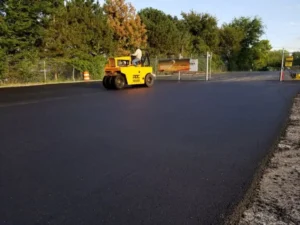Asphalt Paving Installation: Quality Matters
When it comes to installing asphalt paving, quality is of the utmost importance. If the job has been done right, the blacktop will be level, smooth, and neat.
A shoddy job, on the other hand, will be evidenced by rough, uneven, and generally unattractive pavement.
While a good paving job can sometimes go overlooked, it’s hard to ignore a bad one.
For example, you’ve probably seen paving jobs where it looked like the blacktop was literally dumped and splattered over a given area, with no clean-cut edges or smooth transitions to speak of.
This type of common occurrence should give us a good idea of the workmanship, technique, and skill level that is required to produce a quality asphalt paving job. There are several steps that your Austin paving company will carry out in order to install a high-quality blacktop surface.
Below is a general overview of the process:
1. Preparing the Subgrade Area
If the installation is being performed as a new construction, your paving contractor should take great pains to ensure that the soil subgrade has been adequately prepared, graded and compacted, so that the surface is absolutely level.
This may include removing any loose rocks or stones, as well as “soft” soils such as clay or sand.
That doesn’t mean that the ground cannot have any slope, as we know that many driveways and other surfaces do sit at an incline.
But the ground must be level in the sense of not having any dips, bumps, or other surface aberrations that could cause problems once the asphalt layers have been applied.
If the paving job is being performed to replace an existing pavement installation, the old pavement will need to be dug up and removed.
If your contractor will be extending or expanding upon an existing pavement installation, precision saw-cutting or milling techniques may be used to create a smooth transition between the two pavement surfaces.
2. Building the Subbase and Base
Your paving contractor will then build a subbase and base layer (directly above the soil subgrade) using aggregate material such as crushed stone or gravel.
Normally 4-6 inches thick or more, this will provide solid support for not only the asphalt but for the vehicles that will park or drive upon it as well.
This is not something that can be left up to guesswork; it takes an experienced and knowledgeable paving contractor in Austin, TX to determine the right amount of base material necessary to meet the standards for each particular project.
In fact, the entire process requires an extreme level of precision and attention to detail, which is why a job like this is always best left to a trained professional.
3. Drainage Considerations
When it comes to blacktop paving installations, water can be a formidable nemesis.
If the installation is done incorrectly, it will be easy for water to collect on the surface of the pavement which can eventually cause potholes, alligator cracking, heaving (formation of ice crystals in the soil beneath the pavement), or even collapsing of the ground beneath the pavement.
Your paving contractor should make the appropriate considerations for water drainage by ensuring that the pavement has the proper slope and grade to facilitate efficient water runoff.
These considerations may include gutters and curbs that will direct water runoff to the appropriate catch basins or storm drains, in order to avoid potential water damage issues.
All of these factors must be taken into account when planning out a paving installation, showing once again why this type of precise and highly detailed work is best carried out by a qualified contractor.
4. Applying the Asphalt
After the base has been built to exacting specifications, your paving contractor will then begin laying down the asphalt.
This process is done in a series of layers known as “courses”, where each layer (or course) must be rolled and then carefully compacted to ensure a smooth, evenly-finished product.
Using specialized equipment, the asphalt is heated to a high temperature in order to make it easier to spread across the surface. If the semi-liquid mixture is allowed to cool too much, it will hinder the flexibility of the asphalt, making it difficult to apply an even course.
Generally speaking, 3 to 6 inches of compacted asphalt will be adequate for most driveway projects, although your paving contractor will give you the best recommendations based on your specific situation.
The thickness of the asphalt pavement will vary depending on the type of vehicles and loads it will support, as well as the condition and thickness of the subbase.
5. Smoothing Out Transitions
Your paving contractor must not only consider the quality of the surface covering itself, but also how it connects with the streets, sidewalks, etc. that surround it.
The last thing you would want is to have a big “hump” or other pronounced inconsistency in these transitions, as they can not only produce a jarring effect but can also hinder the proper drainage of water from the pavement.
One of the most common techniques that your paving contractor might use to smooth out these transitions is a process known as asphalt or pavement “milling”, which involves removing and reshaping part of an existing paved surface using a specialized piece of equipment.
6. Applying the Surface Course
The last step in the process is to apply the surface course, which is basically the icing on the cake. Your Austin paving company will typically use a roller truck (aka “road roller”) to carry out this task.
This final roll is designed to create a smooth surface that is free from protruding aggregates or other surface irregularities that can hinder the pavement’s functionality.
Once this final layer has been applied and the asphalt has time to dry and settle, your pavement installation will be ready for use!







